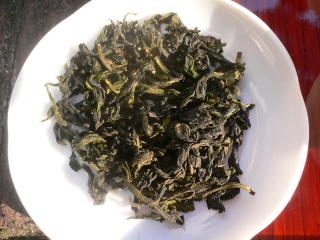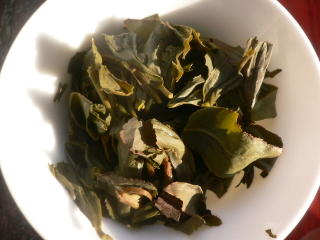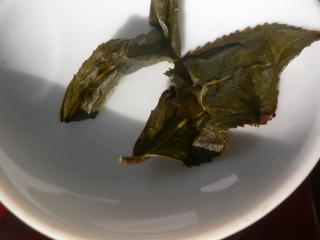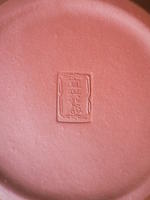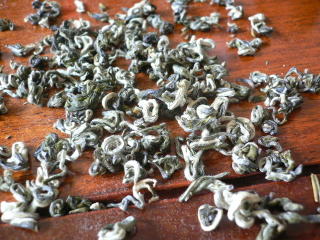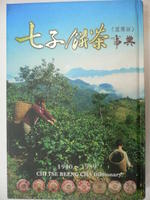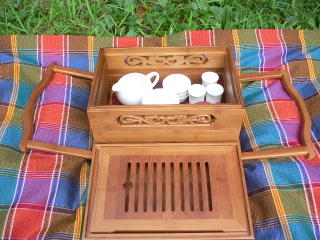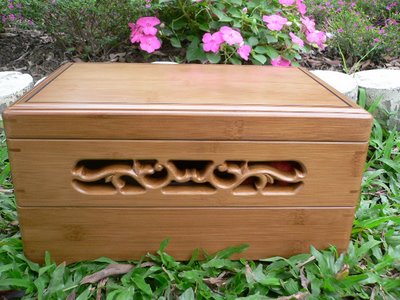
Easy ordering process:
1. Send me an e-mail at: stephane_erler@yahoo.com to request my price list,
2. Send me another e-mail with your detailed order and await my confirmation,
3. Use Paypal to wire your payment.
Here is my selection of teas and ware (*):
PU ERH
Raw:
- Mid 1960s loose puerh,
- Early 1970s loose puerh,
- Mid 1980s loose puerh,
- 1988 Menghai '8582' puerh cake sample
- 1989 Menghai '8582' puerh cake sample
- 1990 Old arbor Yiwu loose puerh,
- 1999 Spring Menghai '7542' qizi bing
- 2003 Spring wild top grade Yi Wu Pu Er Qizi Bing Cha,
- 2006 Spring wild Lincang Puerh Qizi Bing
OOLONG from Taiwan & Fujian
- 2014 Spring Qingxin Oolong from Da Yu Ling (2300 m)
- 2014 Spring Guei Fei Oolong from Shan Lin Xi (1500 m)
- 2014 Spring Qingxin Oolong from Qilai Shan (2050 m)
- 2014 Spring Qingxin Oolong from Shan Lin Xi (1500 m)
- 2014 Spring Qingxin Oolong from Alishan (1500 m)
- 2014 Spring Jinxuan Oolong from Alishan (1500 m)
- 2014 Spring Hung Shui Oolong from Shan Lin Xi (1300 m)
- 2014 Spring Sijichun Oolong from Zhushan
- 2014 Spring Jade Oolong from Zhushan
- 2014 Spring Jinxuan Oolong from Zhushan
- 2013 Late Winter Si Ji Chun Oolong Dong Pian from Zhushan
- 2013 Late Winter Jinxuan Oolong Dong Pian from Zhushan
- 2013 Winter Hung Shui Oolong 'strong' from Yong Lung (Dong Ding)
- 2013 Winter Hung Shui Oolong from Yong Lung (Dong Ding)
- 2013 Winter Luanze Oolong from Shan Lin Shi (2000 m)
- 2013 Winter Hung Shui Oolong from Shan Lin Shi (1500 m)
- 2013 Winter Hung Shui Oolong 'strong' from Shan Lin Shi (1500 m)
- 2013 Summer Oriental Beauty from Hsin Chu
- 2013 Spring Competition Oolong from Dong Ding
- 2013 Spring Luanze Oolong from Li Shan (2200 m)
- 2013 Spring Luanze Oolong from Qilai Shan (2050 m)
- 2013 Spring Luanze Oolong from Lushan (1600 m)
- 2013 Spring Guei Fei Oolong from Ali Shan (1500 m)
- 2013 Spring Concubine Oolong from Feng Huang (Dong Ding)
- 2013 Spring Luanze Oolong from Ali Shan (1500 m)
- 2013 Spring Luanze Oolong from Shan Lin Shi (1400 m)
- 2013 Spring Luanze Oolong from Shan Lin Shi (1200 m)
- 2013 Spring Jinxuan Oolong from Ali Shan (1500 m)
- 2013 Spring Tie Guan Yin with roast from Pinglin
- 2013 Spring Luanze Oolong from Yiguang Shan (700 m)
- 2013 Spring Hung Shui Oolong from Yiguang Shan (700 m)
- 2013 Spring Jade Hung Shui Oolong from Zhu Shan
- 2013 Spring Jinxuan Oolong from Zhu Shan
- 2013 Spring Gankou Oolong from South Taiwan (Fresh or roasted version)
- 2012 Winter 'fruity' Luanze Oolong from Alishan (1600 m)
- 2012 Winter Jinxuan Oolong from Alishan (1300 m)
- 2012 Summer Oriental Beauty from Hsin Chu
- 2012 Spring Hung Shui Oolong from Yiguang Shan (700 m)
- 2011 Winter Concubine Oolong from Feng Huang (Dong Ding)
- 2011 Spring Hung Shui Oolong from Shan Lin Shi (1500 m)
- 2014 Spring 4 years old plantation Baozhong
- 2014 Spring 'Subtropical Forest' Baozhong
- 2014 Spring New Plantation Jade Baozhong
- 2013 Winter Baozhong mix
- 2013 Spring Baozhong 'organic'
ANTIQUE TEAWARE
- 1 liter Japanese tetsubin
- Anping jar
TEA BOOKS
- Teaparker's Teapot, Tea cup, Storage, Old Packaging, Nilu, Old tea books
- Beijing National Palace Museum's Yixing Zisha Wares
- Le Livre du Thé, d'Okakura Kakuzô (in French)
* I personally drink and use all the above teas and items. They all come from very reliable and experienced sources I regularly buy from in Taiwan.
- Early 1970s loose puerh,
- Mid 1980s loose puerh,
- 1988 Menghai '8582' puerh cake sample
- 1989 Menghai '8582' puerh cake sample
- 1990 Old arbor Yiwu loose puerh,
- 1999 Spring Menghai '7542' qizi bing
- 2003 Spring wild top grade Yi Wu Pu Er Qizi Bing Cha,
- 2006 Spring wild Lincang Puerh Qizi Bing
OOLONG from Taiwan & Fujian
- 2014 Spring Qingxin Oolong from Da Yu Ling (2300 m)
- 2014 Spring Guei Fei Oolong from Shan Lin Xi (1500 m)
- 2014 Spring Qingxin Oolong from Qilai Shan (2050 m)
- 2014 Spring Qingxin Oolong from Shan Lin Xi (1500 m)
- 2014 Spring Qingxin Oolong from Alishan (1500 m)
- 2014 Spring Jinxuan Oolong from Alishan (1500 m)
- 2014 Spring Hung Shui Oolong from Shan Lin Xi (1300 m)
- 2014 Spring Sijichun Oolong from Zhushan
- 2014 Spring Jade Oolong from Zhushan
- 2014 Spring Jinxuan Oolong from Zhushan
- 2013 Late Winter Si Ji Chun Oolong Dong Pian from Zhushan
- 2013 Late Winter Jinxuan Oolong Dong Pian from Zhushan
- 2013 Winter Hung Shui Oolong 'strong' from Yong Lung (Dong Ding)
- 2013 Winter Hung Shui Oolong from Yong Lung (Dong Ding)
- 2013 Winter Luanze Oolong from Shan Lin Shi (2000 m)
- 2013 Winter Hung Shui Oolong from Shan Lin Shi (1500 m)
- 2013 Winter Hung Shui Oolong 'strong' from Shan Lin Shi (1500 m)
- 2013 Summer Oriental Beauty from Hsin Chu
- 2013 Spring Competition Oolong from Dong Ding
- 2013 Spring Luanze Oolong from Li Shan (2200 m)
- 2013 Spring Luanze Oolong from Qilai Shan (2050 m)
- 2013 Spring Luanze Oolong from Lushan (1600 m)
- 2013 Spring Guei Fei Oolong from Ali Shan (1500 m)
- 2013 Spring Concubine Oolong from Feng Huang (Dong Ding)
- 2013 Spring Luanze Oolong from Ali Shan (1500 m)
- 2013 Spring Luanze Oolong from Shan Lin Shi (1400 m)
- 2013 Spring Luanze Oolong from Shan Lin Shi (1200 m)
- 2013 Spring Jinxuan Oolong from Ali Shan (1500 m)
- 2013 Spring Tie Guan Yin with roast from Pinglin
- 2013 Spring Luanze Oolong from Yiguang Shan (700 m)
- 2013 Spring Hung Shui Oolong from Yiguang Shan (700 m)
- 2013 Spring Jade Hung Shui Oolong from Zhu Shan
- 2013 Spring Jinxuan Oolong from Zhu Shan
- 2013 Spring Gankou Oolong from South Taiwan (Fresh or roasted version)
- 2012 Winter 'fruity' Luanze Oolong from Alishan (1600 m)
- 2012 Winter Jinxuan Oolong from Alishan (1300 m)
- 2012 Summer Oriental Beauty from Hsin Chu
- 2012 Spring Hung Shui Oolong from Yiguang Shan (700 m)
- 2011 Winter Concubine Oolong from Feng Huang (Dong Ding)
- 2011 Spring Hung Shui Oolong from Shan Lin Shi (1500 m)
- 2011 Spring Top grade roasted Tie Guan Yin from Fujian, Mainland China.
BAOZHONG from Wen Shan, Taiwan
- 2014 Spring Manzhong BaozhongBAOZHONG from Wen Shan, Taiwan
- 2014 Spring 4 years old plantation Baozhong
- 2014 Spring 'Subtropical Forest' Baozhong
- 2014 Spring New Plantation Jade Baozhong
- 2013 Winter Baozhong mix
- 2013 Spring Baozhong 'organic'
- 2013 Spring Qizhong Oolong (roasted Baozhong)
GREEN TEA from Taiwan
- 2014 Spring Biluochun from San Hsia
- 2014 Spring green Qingxin Oolong from Wenshan
- 2014 Spring Xue Li from Gankou, Southern Taiwan
ORGANIC RED TEA
- 2013 Spring Red Da Yeh Oolong from Taiwan's East Coast
- 2012 Spring Red High Mountain Luanze Oolong from Mojiang, Yunnan, China
- 2011 Spring Big Arbor Dian Hong from Yunnan, China
GREEN TEA from Taiwan
- 2014 Spring Biluochun from San Hsia
- 2014 Spring green Qingxin Oolong from Wenshan
- 2014 Spring Xue Li from Gankou, Southern Taiwan
ORGANIC RED TEA
- 2013 Spring Red Da Yeh Oolong from Taiwan's East Coast
- 2012 Spring Red High Mountain Luanze Oolong from Mojiang, Yunnan, China
- 2011 Spring Big Arbor Dian Hong from Yunnan, China
- 2001 Spring Concubine Oolong from Yong Lung, Dong Ding
- 2000 Spring Hung Shui Oolong from Alishan
- 1979 Oolong from Dong Ding
YIXING TEAPOTS
- 10.5 cl hungni or zisha Xianpiao
- 2000 Spring Hung Shui Oolong from Alishan
- 1979 Oolong from Dong Ding
YIXING TEAPOTS
- 10.5 cl hungni or zisha Xianpiao
- Lotus set: cup and stand
ANTIQUE TEAWARE
- 1 liter Japanese tetsubin
- Anping jar
PORCELAIN
- Ivory white porcelain tea set (gaiwan, pitcher, 3 kinds of cups, tea boat), singing cup, 12 cl teapot, 17 cl teapot
- Ivory white porcelain tea set (gaiwan, pitcher, 3 kinds of cups, tea boat), singing cup, 12 cl teapot, 17 cl teapot
- Qingbai porcelain tea set (17cl teapot, 12cl teapot, mini gaiwan, pitcher, 'singing' cup, mini cup).
- Competition tasting set in white ceramic: 1 cup with cover, 1 cup to put the tea and the display plate
- 4-5 cl: 'Dragon' cup from De Hua
- Qinghua set with bamboo: gaiwan, chahai, cups
- small qinghua jars (right hand shape available), small qinghua jar
- Medium qingbai jar with transparent dragon drawing
TEA USTENSILS
- 1.4 liter: modern tetsubin
- 13 cl glass teapot
- Active bamboo charcoal
- 'Magic' sponge
- Cha Bu: Side 1 : Flowers on dark pink, plain dark green, grey with patterns, purple with lines or black with patterns. Side 2: Plain black. Big, long or small.
- Qinghua set with bamboo: gaiwan, chahai, cups
- small qinghua jars (right hand shape available), small qinghua jar
- Medium qingbai jar with transparent dragon drawing
TEA USTENSILS
- 1.4 liter: modern tetsubin
- 13 cl glass teapot
- Active bamboo charcoal
- 'Magic' sponge
- Cha Bu: Side 1 : Flowers on dark pink, plain dark green, grey with patterns, purple with lines or black with patterns. Side 2: Plain black. Big, long or small.
TEA BOOKS
- Teaparker's Teapot, Tea cup, Storage, Old Packaging, Nilu, Old tea books
- Beijing National Palace Museum's Yixing Zisha Wares
- Le Livre du Thé, d'Okakura Kakuzô (in French)
* I personally drink and use all the above teas and items. They all come from very reliable and experienced sources I regularly buy from in Taiwan.

